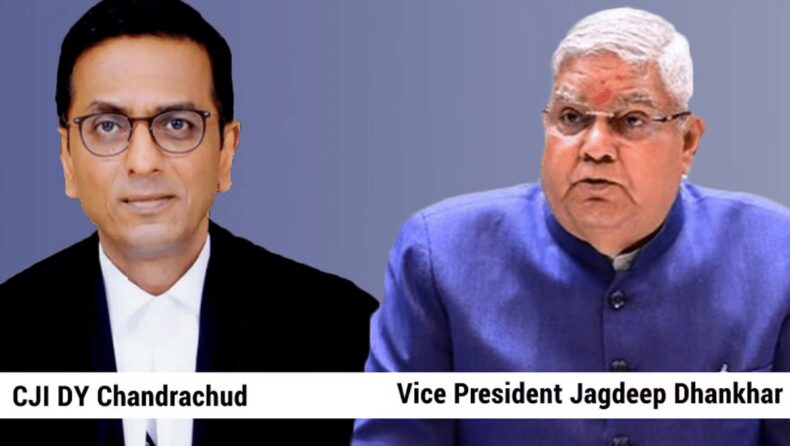The Basic Structure Doctrine is a fundamental principle of Indian constitutional law that holds that certain basic features of the Constitution are essential and cannot be amended or destroyed by any governmental action.
The renowned Supreme Court ruling by a 13-judge Constitution Bench approximately five decades ago transformed the fundamental structural theory. However, the verdict has lately come under fire from India’s Vice President Jagdeep Dhankhar, who claimed that it established a bad precedent and questioned if the judiciary could restrain the Parliament’s authority to amend the Constitution and enact laws in a democracy.

The concept originated in the well-known case of Kesavananda Bharati v. State of Kerala, 1973, in which Bharati was represented by an eminent jurist Nani Palkhivala. The Chief Justice of India DY Chandrachud observed, “If not for Nani, the basic structural theory would not have existed in India,” when discussing Palkhivala’s contribution to the concept.
“The basic structure of our Constitution, like a north star, guides and gives a certain direction to the interpreters and implementers of the Constitution when the path ahead is convoluted,” he added.
One of the key aspects of the Basic Structure Doctrine is that it serves as a “North Star” for interpreting the Constitution. This means that when interpreting the Constitution, the courts must look to the basic features of the Constitution as a guide, and ensure that any interpretation is consistent with these features. This helps to ensure that the Constitution is not interpreted in a way that would undermine its core values or allow for the erosion of its basic features.
The solemn document that the founding fathers are committed to your care may likewise be amended, CJI DY Chandrachud continued. Although you are aware of the requirements of your generation, the Constitution is a priceless legacy. You cannot change its identification as a matter of fact. Only the usage of the phrase “founder moms, together with founding fathers of the Constitution,” is something I will add to this expression.

Justice DY Chandrachud on the Basic Structure Doctrine:
The basic structure doctrine’s historical global migration was also identified by the CJI DY Chandrachud. “Whenever a legal concept is imported from another country, it eventually undergoes an identity transformation that depends on regional markets. Following India’s adoption of the fundamental structure philosophy, it spread to our neighbors Pakistan, Bangladesh, and Nepal.
The basic structural philosophy is now being expressed in numerous ways in South Korea, Japan, various Latin American nations, and some African nations. The migration, integration and formulation of the doctrine of basic structure in constitutional democracies across continents is a rare success story of the diffusion of legal ideas of the world. What better tribute exists than this?” he said.
In addition, Justice Chandrachud emphasized that the development of the doctrine of the basic structure had demonstrated that it would be advantageous for a judge to consider how other jurisdictions had handled significant challenges. “However, it is never appropriate to conceal the larger picture of legal culture and local aspects of law, which are determined by the context.
Social reality is the fundamental foundation of law. Law and legal concepts must blend into, embrace and represent our local values, much as the House must be in harmony with its surroundings and context.
“Our institution does not support unrestricted economic liberalism if you look at it. Instead, our Constitution seeks the ideal balance.
CJI DY Chandrachud has himself been one of the strong advocates of the Basic Structure Doctrine. He has consistently emphasized the need for the courts to uphold the Constitution’s basic features to ensure the protection of fundamental rights and the rule of law. In his judgments, he has also pointed out that the Basic Structure Doctrine serves as a safeguard against any attempts by the government to undermine the Constitution and its core values. He has further added that it is the duty of the courts to uphold the Constitution and protect the basic structure.
Justice Chandrachud stated in regards to how courts should interpret the Constitution. “The craftsmanship of a judge resides in interpreting the text of the Constitution with the changing times while maintaining its soul intact.”

Nani Palkhivala’s impact on Justice DY Chandrachud:
The CJI DY Chandrachud decided to bring Nani Palkhivala’s life and thoughts into the context of the historical occurrences that influenced his development as a person. Nani “created the history of contemporary India by living through these times.” And he was a genuine constitutionalist who revealed the Indian Constitution and devoted his entire life to upholding the legitimacy of our Constitution and defending the rights and liberties of Indian citizens. Justice DY Chandrachud continued, “Nani was always at the forefront of defending the spirit of constitutionalism.
CJI DY Chandrachud mentioned a hearing in the Minerva Mills vs Union of India case when the judge discussed the benefits of socialism. Palkhivala had responded to the judge that “Only an idiot would try to jump the Berlin Wall from the West to the East,” and he noted Palkhivala’s remark.
“Nani’s life has been a witness to historic traditions and transitions in India both in the fields of law and economics. Modern nations often require the great imaginative capacity of individuals to transcend the barriers of space and time”, Justice DY Chandrachud added.
He claimed that every once in a while, people like Nani Palkhivala are needed to hold candles in their steady hands in order to illuminate the area around us. He explained to us that the identity of our Constitution is unalterable and we as a people are entitled to a rights-based democracy. As a nation, we are capable of striving for a more prosperous future. Worldwide, there is a belief in prophets who emerge in dark times to warn people that they are heading in the wrong direction. One such prophet was Nani, according to CJI DY Chandrachud.













